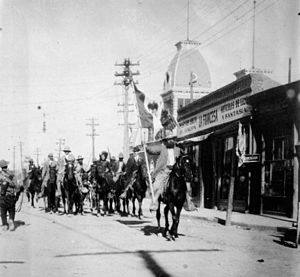Battle of Ciudad Juárez (1911)
| First Battle of Ciudad Juárez | |||||||
|---|---|---|---|---|---|---|---|
| Part of the Mexican Revolution, Border War | |||||||
 Revolutionaries entering Ciudad Juárez. |
|||||||
|
|||||||
| Belligerents | |||||||
| Maderistas |
|
||||||
| Commanders and leaders | |||||||
|
Francisco Madero Pancho Villa Pascual Orozco |
Juan N. Navarro | ||||||
| Strength | |||||||
| 2,500 | 700 | ||||||
The First Battle of Ciudad Juárez took place in April and May 1911 between federal forces loyal to President Porfirio Díaz and rebel forces of Francisco Madero, during the Mexican Revolution. Pascual Orozco and Pancho Villa commanded Madero's army, which besieged Ciudad Juárez, Chihuahua. After two days of fighting the city's garrison surrendered and Orozco and Villa took control of the town. The fall of Ciudad Juárez to Madero, combined with Emiliano Zapata's taking of Cuautla in Morelos, convinced Díaz that he could not hope to defeat the rebels. As a result, he agreed to the Treaty of Ciudad Juárez, resigned and went into exile in France, thus ending the initial stage of the Mexican Revolution.
Diaz's 34-year dictatorial rule met with much opposition, which finally coalesced around the leadership of Francisco Madero. Madero had escaped from prison and, while in exile in the US in November 1910, called for an uprising against Díaz. In the northern state of Chihuahua the call was answered by trader, miner and arms smuggler Pascual Orozco and the "social bandit" Pancho Villa, both of whom began guerrilla operations against Díaz's troops.
Encouraged by Villa's and Orozco's actions, as well as the outbreak of the Zapatista rebellion in Morelos, Madero crossed back into Mexico in February 1911. After a few minor engagements with units of Diaz's army, Madero, Orozco and Villa decided to attack the federal garrison at Ciudad Juárez. If they could take the city, they would control traffic between Mexico and the US. Furthermore, such a major success by the revolutionaries could very well be the final push that would knock over the Porfiriato.
At the same time the attack on the city would mark the first time that the revolutionary army would confront federal forces in a regular battle rather than relying on guerrilla tactics. While the fusion of Madero's, Villa's and Orozco's men did result in a number of troops sufficient to form a force capable of fighting professional soldiers in pitched encounters, the federal troops still had the advantage in terms of training and discipline. The government, in fact, had a good chance of squashing the rebels by moving troops down from the state capital of Ciudad Chihuahua and capturing Madero in a pincer movement. However, the Díaz-appointed governor of the state, Miguel Ahumada, was worried that if the soldiers abandoned the capital unrest would break out and the insurrection would spread. As a further sign of the apparent demoralization of federal rank-and-file soldiers (many of whom had been forcibly conscripted and actually sympathized with the revolutionaries), the troops in Ciudad Chihuahua decided to stay put.
...
Wikipedia
